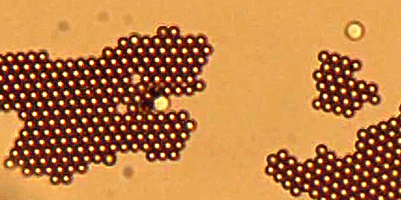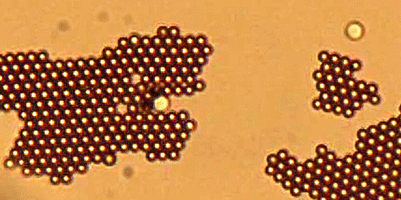Magnetic Carpet Ride
The targeted delivery of medicines and the assembly of microscopic machines require reliable ways of delivering small particles to a precise location. Researchers at the University of Barcelona, Spain, devised a method to transport cells and other small objects on a magnetic “carpet,” which can be steered through a liquid with an external magnetic field. The carpet is made of small magnetic particles that self-assemble into a flat sheet, and it may be useful for transporting delicate cargo that are easily damaged by the electric fields or chemicals used in other techniques.
To make the carpets, Fernando Martinez-Pedrero and Pietro Tierno started with 3-micrometer-diameter plastic beads containing iron oxide, a material that polarizes easily in a magnetic field. They suspended the beads in a liquid layer between two glass slides, which they positioned between magnetic coils that provided fields along two axes in the slide and in the vertical direction. When the authors applied a rotating magnetic field in the plane of the slide, each bead developed a dipole that attracted nearby beads. These forces made the beads organize into a flat sheet. Applying an additional oscillating field along the vertical direction caused the beads to rotate within the sheet, pushing the carpet gently forward through the liquid.
Like a joystick, the three magnetic fields control the motion of the carpets. In one demonstration, the authors scooped a yeast cell onto a carpet and carried it 90 micrometers away—a distance about twice the carpet’s diameter. In another experiment, the carpet passed an obstacle by cleaving and then reforming.
This research is published in Physical Review Applied.
–Jessica Thomas





